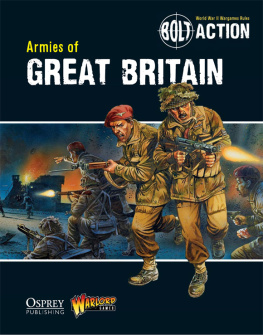
CONTENTS
OSPREY PUBLISHING
Bloomsbury Publishing Plc
Kemp House, Chawley Park, Cumnor Hill, Oxford OX2 9PH, UK
29 Earlsfort Terrace, Dublin 2, Ireland
1385 Broadway, 5 th Floor, New York, NY 10018, USA
Email:
www.ospreypublishing.com
OSPREY is a trademark of Osprey Publishing Ltd
First published in Great Britain in 2004
This electronic edition published in 2021 by Bloomsbury Publishing Plc
Osprey Publishing Ltd, 2004
All rights reserved
You may not copy, distribute, transmit, reproduce or otherwise make available this publication (or any part of it) in any form, or by any means (including without limitation electronic, digital, optical, mechanical, photocopying, printing, recording or otherwise), without the prior written permission of the publisher. Any person who does any unauthorised act in relation to this publication may be liable to criminal prosecution and civil claims for damages.
A catalogue record for this book is available from the British Library
ISBN: 978-1-8417-6662-1 (PB)
ISBN: 978-1-4728-5277-9 (eBook)
ISBN: 978-1-4728-5275-5 (ePDF)
ISBN: 978-1-4728-5276-2 (XML)
Editor: Martin Windrow
Design by Alan Hamp
Osprey Publishing supports the Woodland Trust, the UKs leading woodland conservation charity.
To find out more about our authors and books visit www.ospreypublishing.com . Here you will find our full range of publications, as well as exclusive online content, details of forthcoming events and the option to sign up for our newsletters. You can also sign up for Osprey membership, which entitles you to a discount on purchases made through the Osprey site and access to our extensive online image archive.

Compared with the armies of World War I, the infantrymen of 193945 represented a far smaller proportion of the millions swept up by mass conscription, although they suffered the bulk of the casualties; and in some armies it was decided to mark the status of the battle-tried footsoldier by special insignia. This Obergefreiter of a German mountain unit wears on his left breast the Infanterie-Sturmabzeichen, Infantry Assault Badge, instituted in December 1939 to recognize participation in at least three actions on different days. The peculiarly dangerous nature of infantry work was recognized by the US Army in late 1943 by the Combat Infantryman Badge, which carried additional pay of $10 per month. (Author's collection)
WORLD WAR II INFANTRY TACTICS: SQUAD & PLATOON
INTRODUCTION
INFANTRY MUST IN THE END confirm all success in war. Infantry compels the withdrawal or surrender of the enemy and holds the objectives which have been secured, or the points of importance which have to be protected, as a base for further action. It is the most adaptable and the most generally useful of all arms, since it is capable of operating over any ground by day or night and can find or make cover for itself more readily than the other arms. Such was the opinion expressed in the British Operationsmanual of September 1939; and although many things have changed, this statement probably remains as true today as it was then.
There have been many books on weapons of war; but surprisingly few on tactics, and on the human organization necessary to use those weapons effectively. This two-part work seeks to help redress that imbalance, by a detailed look at infantry tactics in World War II, with the focus on the European theatre and on British, American and German forces. In this first volume we deal with the smallest elements of the armies: individuals, rifle squads, and platoons. (For simplicity, the US term squad rather than the British section will generally be used in this text for the basic tactical unit of ten to a dozen infantrymen.) The second book will address the larger canvas of the infantry company, the battalion, and their support weapons.
The sources used are threefold: contemporary manuals, memoirs, and secondary works. In the manuals we see what soldiers were taught to do or should have done, and the theory behind the tactics. About a hundred manuals have been consulted, including such minor classics as the German Dr Reiberts Dienst Unterricht Im Heere; the British Infantry Training, 1944; and the US manual Scouting, Patrolling, and Sniping, 1944.



















